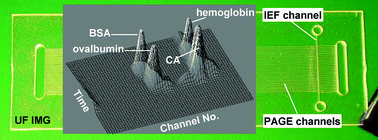Integration of isoelectric focusing with multi-channel gel electrophoresis by using microfluidic pseudo-valves†
Abstract
Two-dimensional (2D)

* Corresponding authors
a
Department of Mechanical and Aerospace Engineering, University of Florida, P.O. Box 116250, Gainesville, FL 32611, USA
E-mail:
hfan@ufl.edu
Fax: +1-352-392-7303
b Department of Physiological Sciences, University of Florida, P.O. Box 100144, Gainesville, FL 32610, USA
c Department of Biomedical Engineering, University of Florida, P.O. Box 116131, Gainesville, FL 32611, USA
Two-dimensional (2D)

 Please wait while we load your content...
Something went wrong. Try again?
Please wait while we load your content...
Something went wrong. Try again?
C. Das, J. Zhang, N. D. Denslow and Z. H. Fan, Lab Chip, 2007, 7, 1806 DOI: 10.1039/B712794D
To request permission to reproduce material from this article, please go to the Copyright Clearance Center request page.
If you are an author contributing to an RSC publication, you do not need to request permission provided correct acknowledgement is given.
If you are the author of this article, you do not need to request permission to reproduce figures and diagrams provided correct acknowledgement is given. If you want to reproduce the whole article in a third-party publication (excluding your thesis/dissertation for which permission is not required) please go to the Copyright Clearance Center request page.
Read more about how to correctly acknowledge RSC content.
 Fetching data from CrossRef.
Fetching data from CrossRef.
This may take some time to load.
Loading related content
